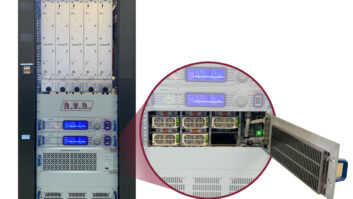There’s nothing more frustrating than hindsight being 20/20! Especially as we are handling the engineering for multiple stations, the problems we need to correct are only multiplied.
(click thumbnail)Figure 1: Sealed conduit
As you plan your week, set aside an “outside” day, grab a tube of RTV sealant or that expanding foam sealant from your local hardware store, and head to the sites.
Any kind of opening is an entry path for a problem. Loose LNB covers provide protected nesting areas for insects and even birds. Open satellite or control cable conduits not only serve as entry points for vermin, water can be inadvertently routed into formerly dry areas.
Figure 1 shows a sealed satellite conduit. Slop a quantity of the sealant around the opening to make removal easier when you need to run another cable in the future.
(click thumbnail)Figure 2: Sealed conduit with pull string
Figure 2 shows the foresight of running a pull string with the coax. Keep this in mind as you install conduit runs out to your dish pad. You know the PD will always add another satellite feed – it’s Murphy’s engineering law!
If you have conduit running out to towers, check the openings on both ends. If they are not sealed, you know what to do. Large diameter conduits, as seen in Figure 3 can be plugged with expanding foam, or stuffed with a rag or steel wool, then sealed with the RTV. Mice are discouraged from chewing by using steel wool. Keep this in mind as you block holes coming from floor cable troughs up into your racks.


. . .
(click thumbnail)Figure 3 : Seal large diameter conduits with a rag or steel wool
As you make your rounds, don’t overlook coaxial entry points in the ceiling. Commercial wall-mounted coax distribution panels provide rubber caps that can be secured with stainless steel hose clamps.
But there’s an economical solution that’s just as effective. In North Carolina, Deborah Proctor and her engineers at WCPE(FM), John Taffee and John Graham, used PVC conduit as a pass through for coaxial cable, seen in Figure 4.
(click thumbnail)Figure 4: PVC pipe provides an economical cable passage
Your local building supplier can provide caps to cover the unused pipes. These caps press-fit over the end, making removal easier. If your coax runs enter the building through a roof or attic, inspect the entry point.
A few years ago, I was called to a station that was off the air. It had rained heavily, and water followed the coax right into the transmitter.
The site was one of those “out-of-sight, out-of-mind,” and because it was only a few years old, the owner saw no reason to spend money for an engineer to inspect it.
There were two problems with the site. First, the coax had been installed so the coax entered the building at the apex of the roof. Although a cable entry port was installed, the rubber was missing, along with the hose clamps. The second problem was that the coax ran straight down from the entry point, right into the top of the transmitter. No horizontal run, no dip or “drip” loop in the line.
There was evidence of some water discoloring the top of the transmitter – indicating this problem hadn’t started overnight. This is another reason to inspect your transmitter site thoroughly. It doesn’t hurt to stand on a stool and wipe off the top of the transmitter with a damp cloth. You might spot something that is ready to fall into the cavity, or that is blocking the exhaust opening.


. . .
Bud Giordano is with WODS(FM) in Boston. In reading our recent column, “Tricks Around the Tank,” Bud added a useful step when working around nitrogen tanks.
After installing a new tank, Bud soaps down the regulator fitting where it attaches to the tank. Using a bottle of children’s liquid bubble soap, any leak is seen as a growing mass of bubbles, which can be rectified before the tank empties. Because the system is under pressure, the soap won’t be sucked into the line, and insuring that the fitting is tight will prevent a wild goose chase looking for a leak on the tower.
I’ve seen the same technique used with a bottle of Fantastik or Formula 409. Usually the liquid will just drip off. If you see any bubbling, you’ve got a leak. Leaks can occur if the regulator fitting is not tight enough, or if you’ve cross-threaded the connector.
Remember not to force the fitting. Hand screwing the fitting, until the threads catch, will guard against cross-threading. Teflon tape is not necessary on the nitrogen tank-to- regulator connection; however, make sure that any of the brass manifolds, Ts or hose fittings have threads wrapped with tape.
It’s not a bad idea to spritz these connections too. A leak can occur on the ground, just as easily as it can up on the tower. Bud ends his tip by noting just how much nitrogen can be lost through a minor leaky connection.
He’s right, a few minutes of checking your work can pay off in eliminating headaches later.
. . .
While we’re on the subject of gas pressurized lines, if you don’t have a low-pressure alarm switch or pressure gauge connected to your remote control, consider this investment.
These sensors mount on an existing gas manifold, or can be connected using a T. The pressure transducer manufactured by Phartronics gives a DC voltage proportional to the line pressure. When connected to a dial-up remote control, the line pressure can be monitored any time. With the upper and lower limit features of these remote control systems, you’ll be paged if the line pressure exceeds the limits.
If you’ve ever had to repair the damage to a line or antenna due to loss of line pressure, this is one page you’ll appreciate!
Submissions for this column are encouraged, and qualify for SBE recertification credit. Fax your submission to (703) 323-8044, or send e-mail to[email protected]












